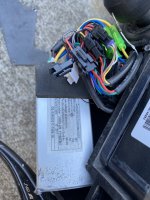What controller are you using? It should have it's own LVC, appropriate to the voltage pack it was designed to be used with, normally marked on it's casing.
Does the battery have a BMS?
If it's a 48v battery that is 13s Li-Ion, generally a good stopping point is about 41-42v, which is why that's the LVC for typical 48v controllers.
If it's a 52v battery that is 14s Li-Ion, LVC would be 44-45v-ish.
That leaves the cells (if they are well-matched and/or at least balanced) at about 3.1-3.2v or so, a good safe margin that doesn't stress the cells. (if they are not well-matched and/or balanced, then the lowest-capacity/highest resistance cells could still be stressed by this, as they'll drop lower than the others, and only a monitoring device (like a BMS) with cell-level measuring will be able to tell this is happening to prevent it.
A BMS (whcih is designed as an emergency protection device to prevent cell damage and fire) will usually have the cell-level protection at 2.8v/cell or so...but you don't want to use that as a normal shutoff. This is there in case something is so wrong with the battery that one or more cell groups has enough less capacity (or enough greater resistance) than others that it drops further than they do under load down to the 2.8v minimum safe level. (below that, damage can occur to the cell--more damage the lower it goes, the longer it happens, and the higher the load on the cell when it is happening--if it happens long enough to drain the cell to zero capacity left then it will actually reverse in voltage, which destroys it, making a much worse fire hazard than just running it too low).
Ghost pedalling means not providing any noticeable input to the system. If you don't feel any loading on your pedals, you're probably not providing any of the motive power, depending on the system setup, gear you are shifted into, etc. It's sometimes used by people that don't want pedal to but have to for legal or technical reasons (such as PAS-activated systems that won't operate without the pedals moving, but where the pedals don't actually control the amount of assist, just turn it on by moving).
Sometimes it looks or feels like ghost pedalling, but isn't: You could be providing input without really feeling it if you are shifted into a low enough gear and are pedalling fast enough, since power is torque x RPM so if you spin faster it takes less torque (pressure on the pedals) to do the same amount of work.... This could happen either by design or if you never shift gears and/or your gearing is incorrect for the speeds / terrain you ride on.
To find out what 0.3v of your pack's capacity is worth in miles, you'd need to calculate what that is in Wh, and know your Wh/mile average usage. (A wattmeter will help you determine this, along with an odometer and a bit of math--the Cycle Analyst includes all this in one package so you don't have to do any math to get Wh/mile). Or measure the riding distance difference between riding while pedalling enough to keep 0.3v above what you'd see at the same points as when riding without pedalling.


